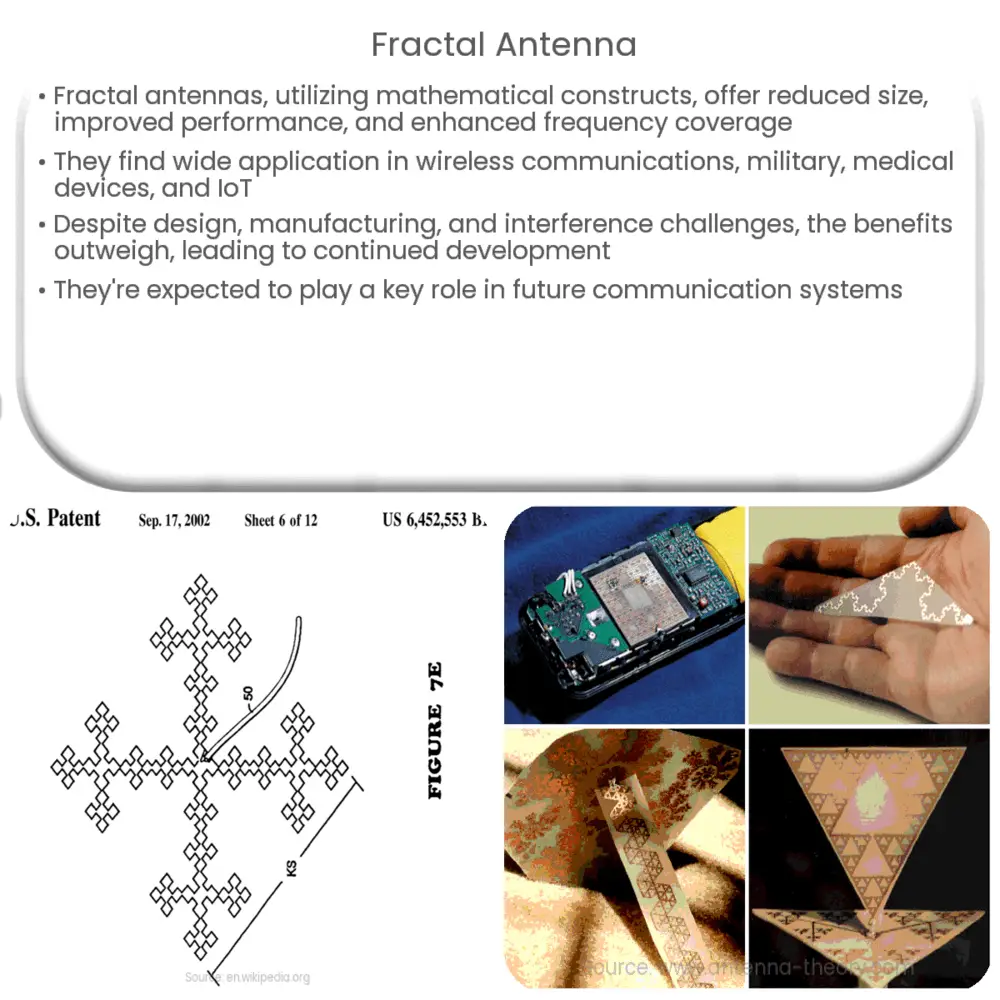Fractal antennas offer reduced size, improved performance, and wide frequency coverage, making them ideal for wireless communication, defense, and IoT applications.

Fractal Antennas: A Revolutionary Approach to Compact and Efficient Antenna Design
Fractal antennas have emerged as a groundbreaking innovation in the field of antenna technology, offering unique benefits such as reduced size, improved performance, and enhanced frequency coverage. This article will explore the concept of fractal antennas, their applications, and the advantages they present compared to traditional antenna designs.
What are Fractal Antennas?
Fractal antennas are designed using geometrical shapes called fractals, which are mathematical constructs characterized by self-similarity and scale invariance. These shapes can be scaled up or down indefinitely while maintaining their essential structure. In the context of antennas, fractals are employed as the radiating elements, which results in antennas that exhibit improved performance across a wide range of frequencies.
History and Development of Fractal Antennas
The concept of fractal antennas was first introduced in the late 1980s by mathematician and electrical engineer Nathan Cohen. Cohen’s initial research focused on the use of fractal shapes to create antennas with reduced dimensions and enhanced performance. Over time, the application of fractals in antenna design has evolved, with researchers discovering new ways to utilize these unique geometries for improved signal reception and transmission.
Applications of Fractal Antennas
Fractal antennas have found a wide range of applications in various fields, including:
- Wireless Communications: Fractal antennas have become increasingly popular in wireless communication devices such as cell phones, Wi-Fi routers, and GPS receivers due to their compact size and multi-band capabilities.
- Military and Defense: The defense sector has leveraged the benefits of fractal antennas for secure communication systems, radar, and surveillance equipment, providing improved signal coverage and reduced interference.
- Medical Devices: Fractal antennas are employed in medical devices for wireless telemetry, biosensors, and imaging applications, offering enhanced performance and reliability.
- Internet of Things (IoT): With the rapid growth of IoT devices, fractal antennas’ multi-band and compact design characteristics make them ideal for various IoT applications, providing reliable and efficient communication between devices.
Advantages of Fractal Antennas
Fractal antennas offer several distinct advantages over traditional antenna designs, including:
- Size Reduction: Fractal antennas can be significantly smaller than their conventional counterparts while maintaining similar performance, making them ideal for portable and space-constrained devices.
- Multi-band Performance: Due to their self-similar nature, fractal antennas can operate efficiently across a wide range of frequencies, making them suitable for multi-band and wideband applications.
- Improved Signal Reception: Fractal antennas exhibit better signal reception capabilities compared to traditional antennas, leading to improved communication quality and reduced signal loss.
- Cost and Material Savings: The compact size and reduced material requirements of fractal antennas can result in cost savings and reduced environmental impact compared to traditional antenna designs.
Design and Construction of Fractal Antennas
Fractal antennas are designed using a variety of fractal geometries, such as the Sierpinski triangle, Koch curve, Minkowski fractal, and Hilbert curve, among others. These geometries can be iteratively repeated to create complex structures with unique properties. The choice of fractal geometry depends on the specific requirements of the application, such as frequency range, bandwidth, and directivity.
Fractal antennas can be constructed using various materials and fabrication techniques, including printed circuit boards (PCBs), microstrip lines, and even 3D printing. The choice of material and fabrication method depends on factors such as the desired frequency range, environmental conditions, and manufacturing constraints.
Challenges and Future Developments
While fractal antennas offer numerous advantages, they also present certain challenges that researchers and engineers are actively working to address. Some of these challenges include:
- Complex Design and Optimization: The intricate geometries of fractal antennas require advanced design and optimization tools, which can be computationally intensive and time-consuming.
- Manufacturing Constraints: The fabrication of fractal antennas, particularly at smaller scales and higher frequencies, can be challenging due to limitations in manufacturing techniques and material properties.
- Interference and Coupling: In multi-band and multi-element fractal antenna arrays, managing interference and coupling between elements can be a complex task, requiring careful design and analysis.
Despite these challenges, ongoing research and development efforts continue to explore new fractal geometries, materials, and fabrication techniques to further improve the performance and capabilities of fractal antennas. Additionally, the integration of advanced materials such as metamaterials and the application of machine learning algorithms for design optimization are promising areas of research that could further enhance the performance of fractal antennas in the future.
Conclusion
Fractal antennas represent a significant advancement in antenna technology, offering unique benefits such as reduced size, improved performance, and enhanced frequency coverage. Their applications span across various fields, including wireless communications, military and defense, medical devices, and the Internet of Things. Despite the challenges associated with their design, fabrication, and optimization, fractal antennas continue to gain traction due to their numerous advantages over traditional antenna designs. Ongoing research and development efforts promise to further enhance the capabilities of fractal antennas, making them an integral part of next-generation communication systems and technologies.



